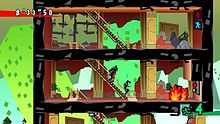Exit (video game)
| Exit | |
|---|---|
 North American boxart, PSP version | |
| Developer(s) | Taito MOSS (Nintendo DS)[1] |
| Publisher(s) | PSP, XBLA DS |
| Composer(s) | Hideki Takahagi |
| Platform(s) | PlayStation Portable, Xbox 360 (XBLA), Nintendo DS |
| Release date(s) | PSP XBLA
|
| Genre(s) | Action/Puzzle |
| Mode(s) | Single-player |
| Distribution | UMD, Download, DS Game Card |
Exit is a 2005 action/puzzle video game that was developed and published by Taito for the PlayStation Portable. It was first released in Japan, on December 15, 2005, in North America on February 14, 2006, in Australia on March 30, 2006, and in Europe on March 31, 2006. A version for Xbox Live Arcade was released on October 24, 2007.[2][3] A version for the Nintendo DS was released in Japan in January 2008.
Overview
The basic premise is to lead the main character Mr. ESC, an escapologist, out of hospitals, underground facilities, offices and other buildings within a time limit. Along the way, the player will be hindered by obstacles such as fires, earthquakes, floods, or even meteor showers.
Sometimes the player must help trapped individuals escape as well, and it will take quick thinking and planning ahead to exit the building successfully.
Characters
- Mr. ESC: A very professional escape artist with an eye for coffee like nobody's business.
- Jet: What may be considered as a "villain", but is not much more than a rival escapologist with a jetpack. Only appears if you bring your companions to their doom or run out of time.
- Companions: Several people throughout the scenarios of which you have to escape. May it be children, young adults, fat adults, or patients.
Gameplay
Each level includes a starting point for Mr. ESC and an exit point. There may also be one or more trapped individuals within the level, and in many cases, Mr. ESC cannot successfully complete the level unless he rescues some or all of the individuals before he escapes. There is a time limit for completing each level.
Mr. ESC is rather agile, and can swim, run faster, and jump higher, more than any of the other trapped individuals. However, he is still prone to injury from hazards or falls from too high.
The individuals come in four types:
- Youngs - These normal-sized people can climb over moderate height obstacles and can jump, and can also assist each other or Mr. ESC in various tasks.
- Children - Children can only climb over small heights but can be assisted by Mr. ESC or a normal adult. They cannot jump as far as adults, but can traverse passages too small for Mr. ESC or other adults.
- Adults - These waddling large-sized people can push very large objects, but cannot climb over moderate obstacles without help from at least two people (MR. ESC and another adult, or two adults).
- Patients - Injured people must be either carried by Mr. ESC or an adult to the exit, or, if a stretcher is available, wheeled to the exit.

Except for the injured, the player as Mr. ESC can order these people to perform certain tasks, move to specific locations, or pick up, use, or trade tools on the level; however, until Mr. ESC has touched them, they remain in a panicked state and cannot help. These individuals will not willfully put themselves in a bad situation (they will refuse to make a drop they could not survive, for example), but they can still be injured from an indirect event (dropping a crate on them, for example). If a survivor is injured, they are carried to safety by Jet (a competitor of Mr. ESC). If too many survivors are injured to be able to meet the requirement, or if Mr. ESC himself is injured, the level is over and must be restarted.
Obstacles include crates which can be used to create platforms to reach higher ledges, fires that must be extinguished before they can be passed, water hazards which only Mr. ESC can swim in, one-way doors, fallen rock walls, exposed electrical wires, and more. Some tools can be used to remove the obstacle (such as a fire extinguisher to dose a fire or a pick-axe to clear rubble). There are some levels that are dark, and a flashlight is needed to see even part of an area of the level.
After completing a level, a score is given based on the number of people rescued, and the par time for the level. 100 points are possible for each level.
There are a total of 100 different levels, which are designed to appeal to the pick-up-and-play qualities of the PSP. 70 stages are available from the start, and the player can then play through them in any order. A player can repeat the level later to try and beat their previous high score. In addition to the packaged levels, 100 more are available for download off the game's website utilizing the PSP's on-board network functionality. The Xbox Live Arcade version has a total of 220 levels.
Sequel
In late June 2006, Famitsu revealed that Taito was working on a sequel to Exit titled Kangaeru Exit, released elsewhere as Exit 2. It was released in September 2006; a demo of the sequel was released for download in Japan in November 2006. Eventually the game was released for the Xbox Live Arcade on February 25, 2009.
References
- ↑ "Consumer Games" (in Japanese). Moss. 2010-01-15. Retrieved 2010-07-20.
- ↑ Faylor, Chris (2007-10-22). "Exit, Battlestar Galactica on Xbox Live Arcade Wed.". Shacknews. Retrieved 2007-10-22.
- ↑ Exit Set for Xbox 360